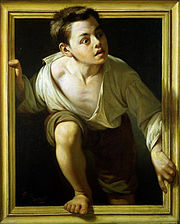|
 Join Us On Facebook
Join Us On Facebook
 Find Us On Pinterest
Find Us On Pinterest
History in Trompe-l'il
 Although
the phrase has its origin in the Baroque period, when it refers to perspectival
illusionism, use of trompe-l'il dates back much further. It was (and is) often
employed in
murals. Instances from Greek and Roman times are known, for instance in
Pompeii. A typical trompe-l'il mural might depict a window, door, or hallway,
intended to suggest a larger room. Although
the phrase has its origin in the Baroque period, when it refers to perspectival
illusionism, use of trompe-l'il dates back much further. It was (and is) often
employed in
murals. Instances from Greek and Roman times are known, for instance in
Pompeii. A typical trompe-l'il mural might depict a window, door, or hallway,
intended to suggest a larger room.
A version of an oft-told ancient Greek
story concerns a contest between two renowned painters. Zeuxis produced a still
life painting so convincing, that birds flew down from the sky to peck at the
painted grapes. He was then asked by his rival, Parrhasius, to pull back a pair
of very tattered curtains in order to see the painting behind them. Parrhasius
won the contest, as his painting was the curtains themselves.
With the superior understanding of
perspective drawing achieved in the Renaissance, Italian painters of the late
Quattrocento such as Andrea Mantegna and Melozzo da Forlì began painting
illusionistic ceiling paintings, generally in fresco, that employed perspective
and techniques such as foreshortening in order to give the impression of greater
space to the viewer below. This type of trompe l'il illusionism as specifically
applied to ceiling paintings is known as di sotto in sù, meaning from
below, upward in Italian. The elements above the viewer are rendered as if
viewed from true vanishing point perspective. Well-known examples are the Camera
degli Sposi in Mantua and Antonio da Correggio's Assumption of the Virgin
in the Duomo of Parma.
Similarly, Vittorio Carpaccio and Jacopo
de' Barbari, added small trompe-l'il features to their paintings, playfully
exploring the boundary between image and reality. For example, a fly might
appear to be sitting on the painting's frame, or a curtain might appear to
partly conceal the painting, a piece of paper might appear to be attached to a
board, or a person might appear to be climbing out of the painting
altogetherall in reference to Zeuxis and Parrhasius.
Trompe l'oeil murals are a quick, affordable and
easy to install solution for
decorating. A wall sized Trompe L'oeil Mural gives
a room special atmosphere and the
feeling of expanded space. Whether they are pre-pasted, un-pasted, or peel and stick, Trompe
l'oeil, Large Murals, Half-Wall Murals, Door
Murals and Poster Murals can instantly transform any room in your home or office! Our highly
detailed Trompe l'oeil wall murals create this illusion by using the latest technology in digital printing.
Wall murals have become the most
popular and cost effective way to decorate. As a
major wallpaper retailer, our purchasing power
allows us to pass along the savings to you. |